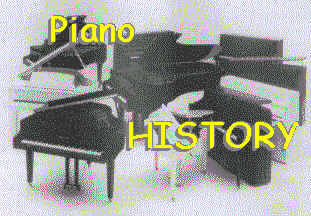HOME
McClard Bros.
Piano
Desk Examples
Commission a Desk
Guestbook
Date
a Piano
Piano History
Piano Care
Contact Information
|

The History of the Piano
Pianoforte. The Piano was invented about 1710
by Bartolommeo Cristofori (1651-1731), a
harpsichord maker in Florence. The piano differs
form its predecessors, the harpsichord and the
clavichord, in the fact that it uses a hammer to
set the strings in vibration. For many years
after its invention the piano was only made in
the large horizontal wing or tail form, which was
mainly a harpsichord design. With modifications
to suit various requirements, this is still the
most important form of the instrument, and bears
the name of 'Grand'. Upright pianos are thought
to have been first made by C.E. Friederici of
Gera in Germany. Hawkins was the first to adopt
overspun strings for the bass, and to construct a
complete iron frame.
Thomas Loud (1802) introduced diagonal
stringing in upright pianos. By varying the
proportions and adjustment of parts, piano makers
have been able to produce differences in tone,
power and touch. Certain essential parts are
common to all pianos. Besides the case there is
the 'frame,' which sustains the tension of the
strings; the 'sounding-board,'; which is the
voice of the instrument; and the 'action,' which
is the mechanism that sets the strings in
vibration.
Music for the piano is written on the bass and
treble staves, and like the organ, the piano is
tuned to the system of equally tempered
intervals. Equal Temperament is the mode of
tuning now applied to all fixed-tone instruments.
In it, the octave is divided into twelve steps,
each note being the same ratio to the one
immediately above and below it. In 1936, a piano
keyboard with a 17 note octave was introduced by
A.C. Ogolenet, a Moscow musician. His inspiration
came from the fact that the present keyboard did
not differentiate between sharps and flats. The
first method of playing an ordinary piano by
mechanical means seems to have been invented by
Debain of Paris about 1848.
|